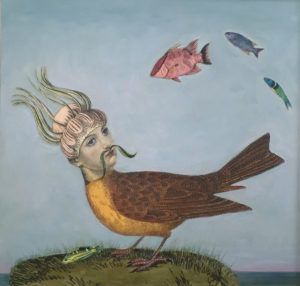
Mustache
ALBUQUERQUE, N.M. — The Mariposa Gallery, now celebrating its 42nd year, is hosting “ORBIT,” a visually provocative seven-artist collage exhibition inspired in part by dada, surrealism and postmodernism.
The show is the result of a series of gatherings of collage artists who formed a loosely defined support group to share ideas and techniques. The artists chose the same one or two images based on vintage photographs of the moon as a theme for the exhibit.
The group includes Roberto Appicciafoco, Zach Collins, Jeff Drew, Kelly Eckel, Valarie Roybal, Suzanne Sbarge and Greg Tucker.
The broad variety of approaches and use of the lunar pictures reveal how creativity can be beautifully enhanced rather than squelched by limitations.
The range covered in the 22-piece collection runs between pure collage works without the obvious hand of the artist to predominantly hand-painted pieces like Sbarge’s offerings and Tucker’s mostly wood construction.
Although Pablo Picasso and Georges Braque coined the term “collage” from the French word “coller” (to glue) in the early 20th century, the technique of gluing overlays of paper and imagery together actually began in China around 200 BC. From there, the technique traveled to Japan by the 10th century and finally arrived in Europe during the 13th century.
Until Picasso and Braque reinvented collage as a modernist fine arts technique, collage was a decorative craft mostly practiced by women.
Appicciafoco, who considers collage to be a liberating process, is inspired by music, films and everything else he sees. His well-executed images – such as the truly stunning “Honeymoon,” an organic view of space, and “Rocket Girl” – have the look of carefully designed pop-surrealist paintings with hints from graphic artists like Andy Warhol of course sans soup cans and scrub pad boxes.
Collins works in miniature to create constructivist compositions that are the most successful abstract miniatures I’ve seen. I love the fact that a large section of the moon can be captured in a less than 4-inch rectangle. Collins has a great sense of composition and scale. His earth-tone palette lends a tasteful touch as well.
Drew presents a series titled “Secret History of the Moon,” which includes an image of a woman about to bite into the Earth as she holds our world in her well-manicured hand, replete with brightly polished fingernails.
The mandala form inspires Eckel in “Patterns,” a dynamic design with embellishments.
Roybal offers “Saturn Man” to the fray, a nicely designed juxtaposition between the business-suited human and his saturnine head.
I have not always been a fan of works by Sbarge, but over the years I have come to truly appreciate the careful artistry that she puts into her collages and have turned a corner regarding her beautifully executed selections.
Besides a great sense of design and color, her work has evolved from early inspirations drawn from her mentor, Holly Roberts, into a personal iconography that is most often breathtaking. Three pieces drew my attention. “Wild Turkey,” in the gallery but not the show, “Arctic Owl” and “Duck” are all near perfection of technique and mysterious.
Longtime newspaper, magazine and book illustrator Greg Tucker, who studied fine arts from childhood through university, is offering “Lunar Rhythmic Device” a beautifully rendered mixed-media sculpture.
Tucker’s four-wheeled “machine” features a wind-up metronome that emblemizes the moon’s regular influence on earthly events like ocean tides, women’s menstrual cycles and, according to his artist’s statement, creativity among artists and scientists.
Although these connections may indicate a modicum of lunacy, the show makes one wonder whether Allen Ginsberg wrote “Howl” under the influence of a full moon. It’s a great show, and the gallery is chock-full of other notable creations.
